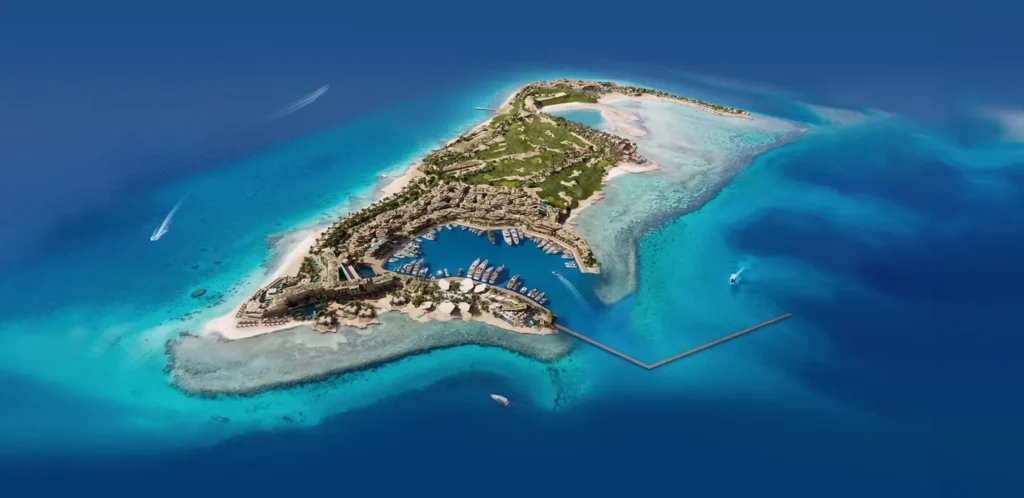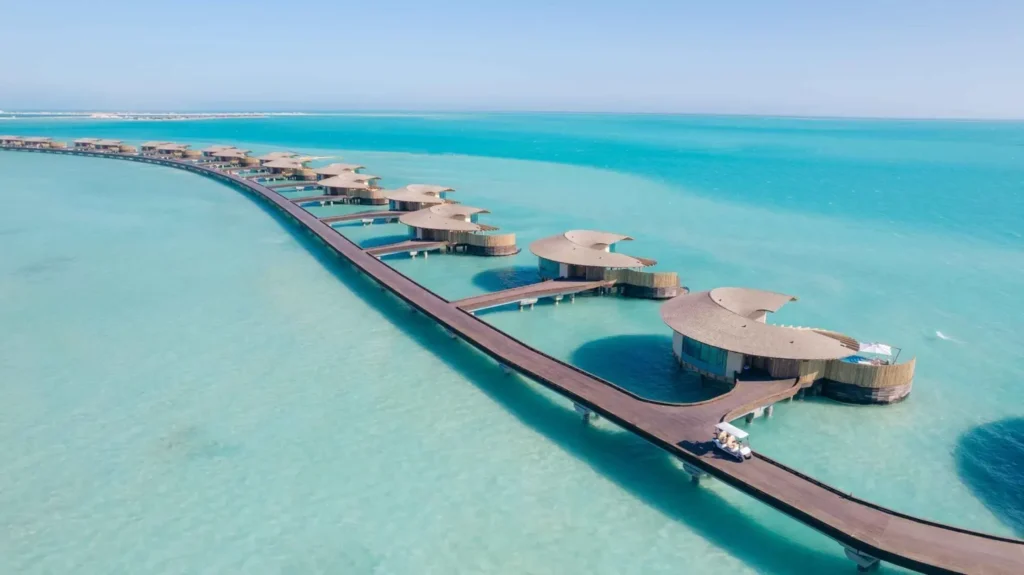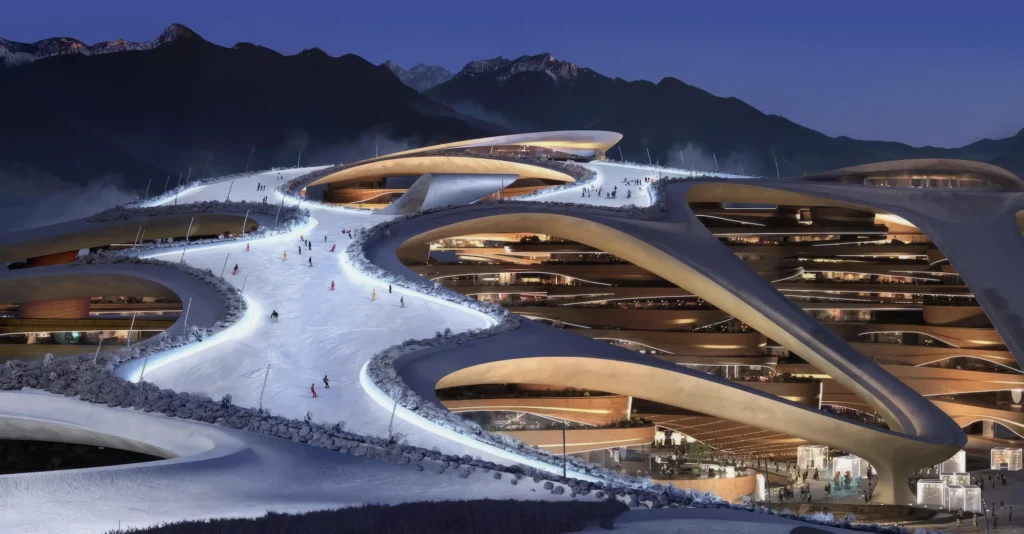Prepare to witness a significant transformation in your perception of Saudi Arabia as a travel destination. Imagine Sindalah, a 7-star private island resort featuring three ultra-luxe resorts, 38 high-end restaurants, and multiple superyacht marinas.
Picture Qiddiya, a futuristic city dedicated to e-sports and gaming, rising from the desert floor with a population of 600,000. Envision Trojena, a space-age ski resort perched above the high desert. Delve into The Red Sea, an expansive waterscape hosting 50 luxury resorts and 8,000 hotel rooms across 22 islands in a Maldives-style archipelago, powered entirely by wind and solar energy. Also in progress is The Rig, a $5-billion adventure theme park constructed on an offshore oil platform. Saudi Arabia is positioning itself as a cruise destination, bolstered by a recent $300-million ship acquisition. The kingdom is undergoing a monumental physical transformation, witnessing the emergence of new roads, airports, golf courses, and cruise terminals across its expanse. The map is dynamically reshaping in real-time.
Adding to this evolution are the numerous new hotels, each with thousands of freshly built rooms. Renowned hospitality giants like Ritz-Carlton, Four Seasons, St. Regis, Fairmont, Marriott, Hilton, Hyatt, and InterContinental are eagerly participating in a construction surge that surpasses any other globally. While individual projects might momentarily capture the travel industry’s attention, the collective transformation in Saudi Arabia demands recognition.
The magnitude of Saudi Arabia’s physical metamorphosis can be challenging to grasp. Key projects, such as the 7-star private island Sindalah and the improbable desert ski resort Trojena, fall under NEOM—a $500-billion region in northwest Saudi Arabia. NEOM spans 10,200 square miles, bordered by the Red Sea to the south and the Gulf of Aqaba to the west, equivalent to the size of Albania.

Fantasy Island: Sindalah will feature 88 villas, 333 apartments, 51 luxury retail stores and an 86-berth superyacht marina.NEOM
Primarily funded by the Kingdom’s $700-billion Public Investment Fund (PIF), the concept of NEOM originated from Vision 2030, Saudi Arabia’s ambitious initiative to break free from its historical reliance on oil and broaden its economic base. One of the pillars of this initiative involves reimagining the country as a global tourism powerhouse. When initially unveiled in 2016, the Kingdom’s tourism objectives appeared ambitious: attract 100 million visitors annually, both foreign and domestic, and elevate tourism’s contribution to the economy from approximately 3% to 10%—all within a 14-year timeframe.
This vision seemed audacious, especially considering that in 2016, Saudi Arabia had yet to open its doors to international leisure travelers. At that time, entry was predominantly restricted to expatriate workers, those with business visas, and religious pilgrims visiting Mecca and Medina.
However, in 2019, Saudi Arabia announced the issuance of e-visas and visas on arrival for visitors from 49 countries, including the United States. Accompanying this change, female visitors were no longer required to wear an abaya in public places, and they could travel without a male companion. While modest dress codes persisted, Mecca remained exclusive to non-Muslims.
Since embracing the international travel market, Saudi Arabia’s swift and resolute transformation has astonished seasoned tourism analysts. Caroline Bremner, head of travel and tourism research at Euromonitor International, notes the massive investments, reaching trillions of dollars, in infrastructure and economic diversification. The World Travel & Tourism Council (WTTC) estimated Saudi Arabia’s spending at $800 billion, excluding significant foreign investments.
Although the pandemic affected some projects, the Saudis increased their target to 150 million annual visitors by 2030 instead of scaling back expectations. In tourism terminology, a “visitor” is someone who visits a site within the country, not necessarily making an overnight stay. Euromonitor projects over 24 million foreign arrivals in 2023, set to rise to nearly 37 million in 2030. This strategy, coupled with domestic tourists, aligns with achievable targets.
A more significant measure of success lies in foreign spending within Saudi Arabia. Euromonitor predicts international tourists will spend $38 billion in 2030, with the total economic impact, including domestic travelers’ expenditures and the creation of one million new tourism jobs, being far more substantial. The WTTC anticipates that by 2032, Saudi Arabia’s tourism sector could contribute nearly $169 billion to its GDP, representing 17.1% of the total Saudi economy.

Waterworld: The Red Sea Global project features several luxury resorts, including one with overwater bungalows.RED SEA GLOBAL
“Keep in mind, they’re constructing this destination essentially from the ground up for the global market, and they’re enlisting top-tier professionals in terms of personnel,” states Bremner. “I can see that they’ve considered every single aspect of tourism, from the staff to the product, the brand, the service, the connectivity, the sustainability. So it genuinely feels like they’re creating something for the next century ahead.”
Preparing for the future also entails acknowledging the significant shift in preferences among the next generations of global travelers. Approximately 90% of young Chinese travelers and 70% of Gen Z travelers in the UK, Australia, and India express a desire to explore new destinations, according to data from Skift Research. Being the newcomer in the tourism landscape is a considerable advantage in this sense.
“New generations have a lot more information through social media,” notes Billy Canellas, head of asset management at NEOM, speaking at the Skift Global Forum East in December. “[Younger travelers] are very well educated about the effects of overtourism in traditional destinations,” he added, emphasizing “a clear tendency towards eco-friendly and sustainable destinations” and a curiosity about a destination’s “culture and the traditions of diversity.”
“The luxury market is getting more diverse and younger, and it’s shifting to the emerging markets,” says Bremner, highlighting the appeal of the United Arab Emirates, India, and China to this demographic. “We have this fresh-faced luxury traveler, and it’s not the traditional older generation of travelers with lots of money. It’s the New World luxury traveler, highly digital, very environmentally conscious, and for whom social impact is important.”
“Make no mistake,” says Geoff Freeman, president and CEO of the U.S. Travel Association, “what Saudi Arabia is doing is they’re identifying who are some of the most important travelers are—the people willing to spend a lot of money on experiences—and asking, How do we go get them?”
Nevertheless, there are potential pitfalls for the grand Saudi vision. Financial risks loom large, especially when undertaking numerous mega-projects simultaneously, even for a nation with substantial resources. “The Saudis are running at 82% public debt compared to government revenue,” notes Bremner, citing official public debt as a percentage of GDP at 23.8% in 2023. However, this is relative; the Kingdom’s debt-to-GDP ratio, nearly double what it was a decade ago, remains low compared to other countries. For instance, Switzerland’s government debt is 41% of GDP, while the U.S. and Canadian governments’ debt is 133% and 106% of GDP, respectively, and the U.K.’s debt is 98% of GDP.
Bremner’s primary concern is hotel overcapacity, which could potentially depress prices. “That luxury positioning is going to come under a little bit of erosion because [the Saudis] are moving so quickly. With that level of supply, it is quite hard to balance,” she says, adding that Euromonitor International’s latest forecast model predicts a drop in the average traveler’s spend by 2030 due to excess hotel room capacity. “Too many hotel rooms that aren’t being filled will drive prices down, so that’s a risk.”

Sand Dollars: A new Four Seasons is a part of Red Sea Global and will have 149 rooms and suites, a spa and an 18-hole golf course.FOUR SEASONS RESORTS
Furthermore, many prospective tourists, particularly those from the West, continue to have negative perceptions of Saudi Arabia. In addition to accusations of violations of human rights and violence on journalists, the Kingdom continues to impose severe restrictions on women and prohibit alcohol consumption. The murder of Washington Post writer Jamal Khashoggi in 2018 was formally attributed by the United States to Saudi Crown Prince Mohammed bin Salman in 2021.
Multinational firms have continued to invest in the Kingdom’s ambitious plans despite any human rights concerns. According to Bremner, “it will be a very important issue for some players, perhaps a complete barrier to entry.” “That being said, it is evident that most high-end hotel brands have already relocated from China and the United Arab Emirates to Saudi Arabia.”
After all, there are few things that the global travel industry enjoys more than a flashy new location in a developing market, and the Middle East is currently experiencing a moment. According to Bremner, “you have the Middle East in the sort of perfect location—just like Turkey—within a five-hour flight of Western Europe and Asia.”
According to the UN World Tourism Organization’s Tourism Recovery Tracker, despite the outbreak of the Israel-Hamas conflict in October of last year, foreign visits to the Mideast increased by 23% above pre-pandemic levels, making it the region with the fastest rate of growth for tourism in 2023. This is 35% more than the worldwide average, given that the average level of tourism around the globe is still 12 points lower than that of 2019 visitors.
Even yet, slightly over three million American tourists traveled to the area in 2023, accounting for 12.6% of all U.S. tourists traveling abroad. This represents a tremendous 39% increase from 2019. Additionally, the Middle East was the only one of the three regions to see growth since the epidemic, despite having a lower percentage of American tourists than those visiting Europe (40%) and Asia (15.7%) last year.
Freeman, too, is unconcerned about Saudi Arabia’s capacity to draw in a sizable influx of American tourists. He expresses concern that they are attempting to draw in Europeans, wealthy Middle Easterners, and Asians who could have otherwise traveled to the US and spent their money there.
International tourism, after all, is a highly competitive industry where the success of one nation is the loss of another, according to Freeman: “What gives us pause,” he says, “is that other nations now realize that travel is a global competition to figure out who can attract the customer.”

